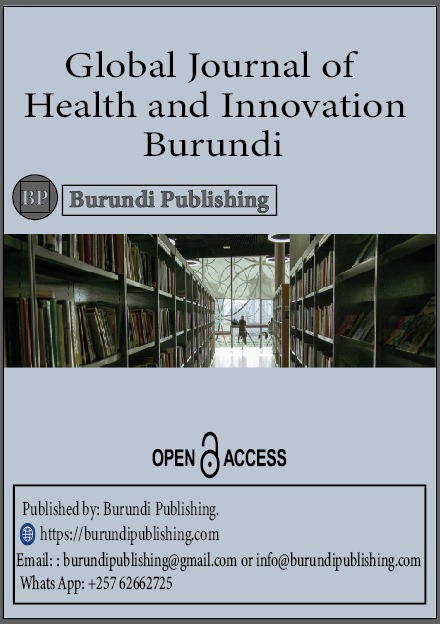FACTORS CONTRIBUTING TO INCREASED CASES OF TOBACCO SMOKING AMONG YOUTH AGED 18-30 YEARS IN KITWE TOWN COUNCIL, NTUNGAMO DISTRICT. A CROSS-SECTIONAL STUDY.
DOI:
https://doi.org/10.70659/gjhib.v2i1.21Keywords:
Increased cases of Tobacco smoking, Youth aged 18-30 years, Kitwe town councilAbstract
Background
Smoking is a significant public health concern, and its prevalence among youth aged 18 -30 is a growing issue. The study aims to establish the factors contributing to increased cases of Tobacco smoking among youth aged 18-30 years in Kitwe town council, Ntungamo District.
Methodology
A cross-sectional study was carried out at Kitwe town council in Ntungamo district using a Simple random sampling technique on 50 respondents who were tobacco smokers.
Results
The study included 50 respondents. The majority (90%) were tobacco smokers, the majority (70%) smoked smokeless tobacco, the majority of the tobacco smokers were male, the majority of the respondents (64%) who smoked tobacco were adolescents, the majority of the respondents (76%) reported that they smoked tobacco to relieve stress. (70%) of the respondents agreed that their parents smoked tobacco, (64%) of the respondents reported that their parents influenced them to smoke, the majority of the respondents (60%) reported that print media was their source of information about tobacco smoking, (92%) of the respondents agreed that their friends smoked tobacco. The majority of the respondents (32%) reported that they had no formal education, the majority of the respondents (60%) earned less than Ugx: 100,000/=, and the majority of the respondents (60%) were of middle-income status.
Conclusion
A generally high percentage of the respondents were tobacco smokers. Factors that contributed to increased cases of tobacco smoking were age and gender, type of tobacco, desire to smoke, psychological status of individuals, and social norms.
Recommendations
The Ministry of Health should increase taxes on tobacco sales to reduce tobacco use by the youth.
References
Aanyu. et al, 2019. advanced from taking ordinally tobacco cigarettes to smoking every kind of weed, yet their knowledge about the health effects is low,
Fagbamigbe et al.,2020. youth in Africa who smoke have education levels with limited awareness of the dangers of tobacco smoking in addition to peers who influence them.
Goodchild, Nargis, & Tursan. (2018). smoking imposes an economic burden on both individuals and the healthcare system,
Haq et al, 2019. China is the largest tobacco consumer, consisting of 300 million current smokers, with an estimated 52.9% being male youth.
Kabwama et al.,2016. Tobacco smoking and exposure to smoke are of the most preventable causes of death and disabilities,
kabwama. et al.,2016. 1 in every 10 people smokes tobacco products daily, and the majority of them are found in western and northern Uganda compared to other regions,
United States of America. (2020). Centers for Disease Control and Prevention.
University, M. (2020). celebrities encourage youth to smoke as they perceive it capable of enhancing self-esteem.
Vu et al., 2020). Tobacco smoking. The leading cause of premature death.
WHO. (2015). Smoking is harmful, but promotions and negative examples from elders like teachers attract them to get initiated into tobacco smoking.
WHO. (2016). In Africa, approximately 9.2% of male and 3.2% of female youth currently smoke,
WHO. (2021). 70% of them lack access to tools and information to help them quit smoking successfully,
Yang. (et al.,2018). sexual dysfunction and various types of cancer like lung cancer,
Downloads
Published
How to Cite
Issue
Section
License
Copyright (c) 2025 Emmanuel Mpangwire, Catherine Musimenta

This work is licensed under a Creative Commons Attribution 4.0 International License.
License Information
All articles published in the Global Journal of Health and Innovation Burundi are licensed under the Creative Commons Attribution 4.0 International License (CC BY 4.0).
This license permits:
- Sharing: You can copy and redistribute the material in any medium or format.
- Adapting: You can remix, transform, and build upon the material for any purpose, including commercially.
Attribution Requirement: Users must provide appropriate credit to the original author(s), link to the license, and indicate if changes were made.






